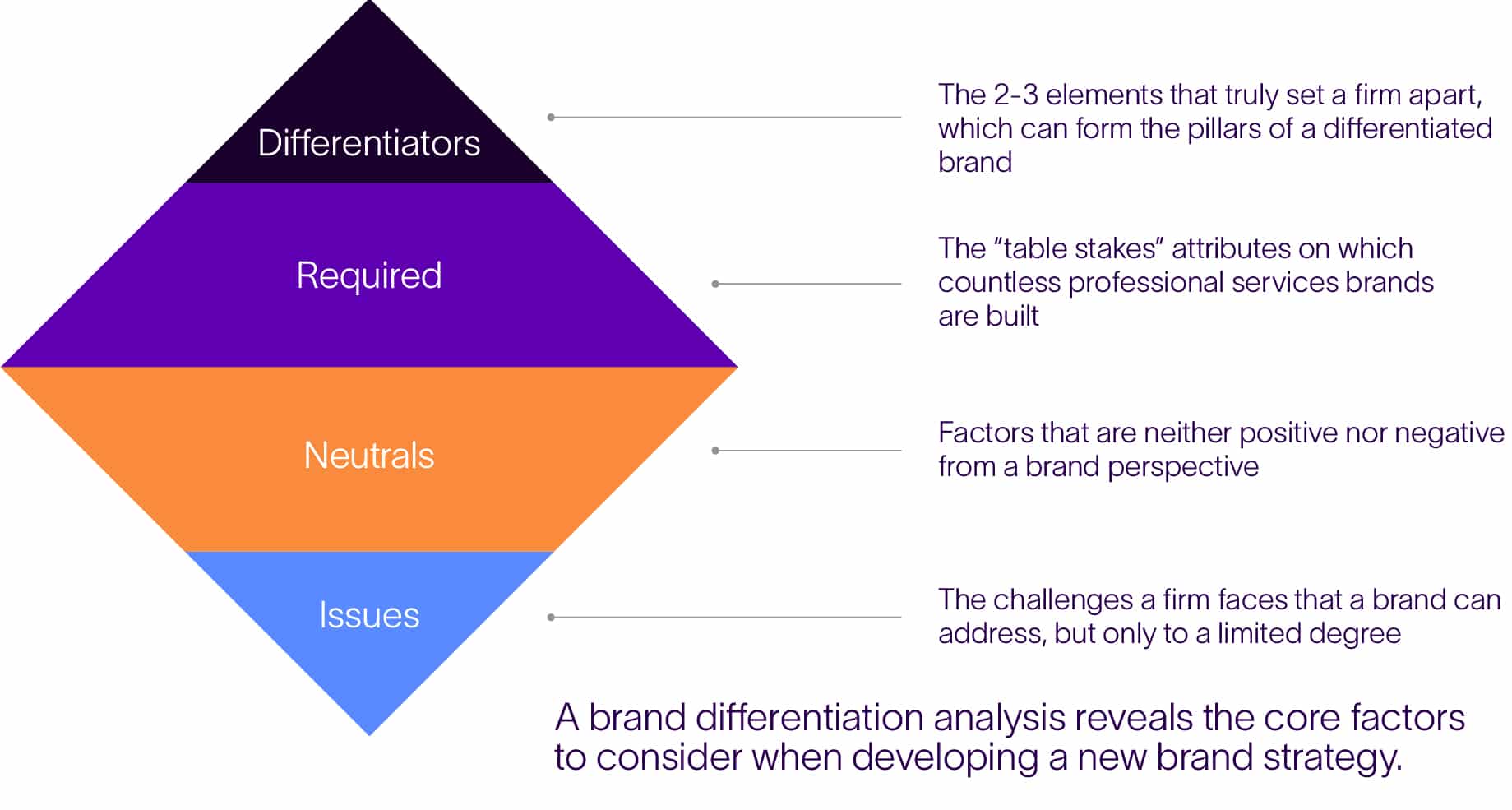For decades, law firms went to market with relatively conventional messages that did little to create compelling impressions in the minds of their audiences, let alone lasting ones. To a large extent, their strategies succeeded nonetheless—thanks to the strength of their benches, their personal networks and the knowledge that big companies had big budgets to spend.
And then came a sea change in the legal industry. Alternative fee structures, vendor reviews, larger and more influential in-house teams—legacies of the 2008 financial crisis—have chipped away at what once seemed like rock-solid outside counsel relationships. Compounding the challenge is the commoditization of the legal industry, with unprecedented numbers of online, outsourced, and product-based competitors joining the fray every day.
With a tougher competitive landscape, consolidation has become a fixture in the marketplace, making it harder for firms to stand out while giants dominate. Law firms that are large, talented and capable—affordably accessible, if not quite white-shoe—have especially struggled. The American Lawyer has described such law firms as stuck in a zone called the “Hollow Middle,” where neither prestige nor rates can ensure business.
“Me-too” brands just don’t cut it in the legal arena anymore. General Counsels, CEOs, CFOs and others are looking for reasons to believe. As routine legal work becomes more commoditized, what law firms offer is becoming less important to legal buyers. Instead, as executives scramble for influence and resources, they’re looking for a methodology and mission that aligns with their greater goals. They’re looking for law firms whose partnership can help them shape strategy and make them look and feel like heroes.
This is where a strong, differentiated law firm brand comes into play. A brand can build and sustain goodwill, providing that extra edge over the competition during evaluation periods and keeping the relationship strong through rough patches.
Naysayers may protest, “This is a people business. Why do we need a brand?” Senior partners and “star” lawyers assume that their clients are choosing them—their knowledge, their expertise, their charisma.
To some extent, they’re right: individual practitioners play a large role in closing deals and building relationships that drive loyalty. But top-of-funnel marketing content creation, cross-selling and succession planning represent just three mission-critical moments when a strong brand can bridge the client acquisition gaps even star performers can’t fill. (For an even closer look at the pitfalls of star-power dependency, see this article in Forbes.)
What are Table Stakes in the Legal Marketplace?
When we recently worked with an AmLaw 200 firm, we began the process by taking a fresh look at branding across the legal space. In doing so, we were struck by how similarly law firms described themselves. By and large–and at a time when the need to differentiate is more critical than ever–law firms communicate the same messages and tout somewhat interchangeable attributes.
An analysis of our client’s top competitors revealed a legal sea of sameness. We remarked more than once that you could substitute copy from one firm’s website for another (e.g., messages centered on “national presence,” “client service,” “capitalizing on opportunity” and “good value”) and never notice. Runner-up attributes were also far from unique: diversity, pro bono work, long history, impressive client roster.
There is certainly nothing wrong with being “focused on the client,” but this doesn’t buy a law firm much in the way of differentiation. After all, if a GC or CEO believed that a law firm wasn’t focused on their needs, would they even consider hiring that firm in the first place? Doubtful. The same is true for that perennial promise to perform “quality” work with “integrity.”
These types of messages are what we call “table stakes.” They’re the must-haves–or “jacks for openers,” to extend the poker metaphor. You need them just to be in the game, but they don’t ensure a winning hand. Yet these are precisely the messages on which many law firm brands are built.
There is evidence that this situation may be changing. Just a few years ago, major law firms like Baker McKenzie and Goodwin embarked on major branding initiatives that distilled each law firm’s essence in a single, compelling idea. This level of activity among the AmLaw 50 indicates there is growing acceptance that differentiation is paramount in a noisy and crowded legal marketplace.
Breaking Through the Clutter with Content
The world is flooded with marketing messages. Most of the largest firms, in all segments of professional services, are attempting to do an end-run around the clutter by focusing their efforts on content marketing rather than traditional communications channels (e.g., advertising). Whitepapers, videos, webinars, surveys and newsletters are an increasingly important component of law firms’ communications platforms. And for good reason. Buyers of legal services are increasingly tuning out when it comes to traditional marketing channels. Prospective law firm clients want to be informed, educated and enlightened—not sold to.
In this increasingly complex and saturated environment, strong content has become a lifeline, something B2B marketers can use to break through and connect with prospects while showcasing a law firm’s brand. It puts a human face on the firm and demonstrates expertise without having to say, “We’re experts.” And when trying to reach the elusive C-suite, it’s even more critical. Executive leaders, more than any other group, positively insulate themselves against traditional advertising and marketing.
Unfortunately, the growing popularity of content as a marketing tool (along with the emergence of content-generating AI tools like ChatGPT) means everyone is publishing and distributing content, including the biggest firms, who now have entire departments devoted to creating whitepapers and other literature. There’s so much content being distributed, in fact, that during the research phase of a recent branding initiative, we found that very few clients were even aware that they were receiving newsletters and whitepapers from their law firms. To cut through the clutter and avoid this fate, it’s vital to be nimble and creative about what content you create and how you distribute it. A strong brand can help simplify these decisions, providing inspiration and a framework for what and where a law firm should publish.
Awareness Starts from Within
Another challenge for law firms, especially those in general practice, is that clients aren’t fully aware of which practice areas or services are offered. This is particularly true for firms that have expanded and diversified through acquisitions or even organic growth. When we surveyed employees of one DeSantis Breindel law firm client, 73% did not think that their own clients understood the full breadth of the firm’s capabilities.
Clearly, this reveals a failure to communicate effectively to clients. But it also indicates a need for better employee training. At all levels, from staff up to partner, everyone at a law firm must know the firm’s complete set of solutions and be prepared to explain it to clients. Of course, employees will need to be incentivized to sell outside their core areas of focus. But at its most fundamental, this problem comes back to branding: all your people must be committed, informed and empowered ambassadors for your brand, each of them able to tell the law firm’s story to clients and prospects and effectively sell its complete offering.
How to Build a Differentiated Law Firm Brand
So, how can a law firm stand out? Is it possible to create a brand that will establish a distinctive and compelling position for the firm? It is. And it starts with information, which is as important to branding as it is to preparing a legal brief.
1. Research current perceptions of your law firm’s brand
Your current brand is the sum of what your most important audiences think about you, and to change it strategically, you’ll need insights born of dedicated research. External interviews generally focus on how the firm is perceived today. But to be effective, this research should also focus on internal audiences—your staff. Employee interviews (of individuals or groups) should focus on how your people perceive the law firm today and where they would like the firm to go in the future. The difference between all current perceptions and the firm’s desired future state is the “brand gap,” which can be bridged with a new brand, provided it is effectively deployed.
2. Analyze your brand for chances to differentiate
In addition to uncovering your brand gap, research will identify the attributes, or pillars, on which to build a differentiated brand. Here, the challenge is to distinguish between Differentiators (the truly unique value proposition that only your law firm can credibly claim) and Required attributes (the ones that all law firms must have to compete), to recognize the aspects of your brand that are Neutrals (motivating neither positive nor negative perceptions) and—importantly—to surface any Issues (negative perception drivers that either branding or some other business initiative should address).
There’s a good reason this schematic is diamond shaped; most firms have a lot more Neutrals and Required factors than Issues or Differentiators.

Subscribe to Our Newsletter
In terms of Issues, maybe you’ve had a lot of attorney turnover recently. Or maybe there’s only a perception of high turnover—from a brand perspective, there isn’t much difference, unfortunately. A new brand might help you project an image of stability. But if you’ve experienced high turnover or your competitors are making that charge against you, the brand can only go so far to counteract the Issue.
Neutrals will differ for nearly every firm. Maybe you’ve been in business for 100 years, and that’s quite an achievement. But does it buy you anything from a prospective client’s point of view? Neutrals aren’t bad things, and they often find their way into supporting messages. But they are not the pillars of a differentiated brand.
Requirements are those table stakes discussed above, the familiar attributes like “experienced team” or “dedicated client service” that everyone likes to talk about (and are precisely the attributes that most legal brands are built on). But they are not really brand pillars. They’re merely essentials.
There are attributes that can support a powerful new legal brand—your Differentiators. Finding the two to three factors that can support a brand isn’t easy—but every firm has them. Identifying Differentiators requires digging deeply through research as well as analyzing the competition and their brands.
In our discovery work with Lathrop Gage, we found that their attorneys were seen as unafraid to “roll up their sleeves” and really discover what makes their clients tick, and perceived as viewing the law as a catalyst for growth vs. a barrier to progress.These findings led to a new brand based on the concept of “See Beyond,” the firm promising to provide vision and solutions beyond narrowly defined legal issues, beyond conventional wisdom, beyond the expected.
3. Develop a differentiated brand position, voice, design language and messaging
Finally, Differentiators need to be woven together into a cohesive law firm brand strategy, first codified in a positioning statement. This statement should be credible and defensible but also aspirational, reflecting not only where the firm is today but where it wants to be. It defines what’s distinct about the firm and what unique, enduring value it delivers to its clients.
Positioning will be expressed through a brand voice. How will your firm “sound” in its communications: aggressive and authoritative or thoughtful and collaborative? Cerebral or practical? With every syllable, this voice signals what the brand stands for.
A brand lives in images as well as words. With its brand strategy in place, the law firm is ready to create its visual brand, or what we call “design language.” A law firm’s design language triggers rational, physical and emotional responses among key constituents, both internal and external. Different forms and shapes, uses of color and graphic styles are incorporated, as are strategies for typography, photography and illustration. The goal is to unlock the key equity components of a brand’s visual expression and ensure consistency across all communications and touchpoints.
Finally, messaging brings the law firm brand’s positioning to life through targeted, strategic communications. Content tells the brand story (in the brand voice) to convey the firm’s unique value proposition in the context of clients’ needs and ambitions–positioning the firm as their ideal partner.
4. Ensure brand strategy compliance through message mapping
Maintaining brand consistency is easier when everyone knows the right message to share at the right moment. At DeSantis Breindel, we always extend the brand strategy to a message map, which we see as a critically important communications tool.
A message map includes a set of core messages appropriate for all of a law firm’s audiences—think of these as the messages you might find on a firm’s homepage. But we also recommend mapping individual messages to specific audiences, including clients, prospects, referral sources, employees and recruits. With a message map to follow for each, law firms can easily develop communications tailored to each important audience without having to guess, each time, about what to say to motivate desired actions.

Once complete, the new law firm brand will differentiate all the law firm’s communications and experiences, from its web presence to advertising to employee engagement programs. To ensure maximum effectiveness, brand implementation should be synchronized at all internal and external touchpoints. This requires significant planning and often demands cooperation among many departments: marketing, human resources, operations, senior management. But it’s worth the investment in up-front planning; if rolled out properly, the brand will create value each time it touches an internal or external audience.
Finding a unique brand position in a field as crowded and competitive as legal services isn’t easy. It’s tempting to fall back on safe ideas and familiar claims rather than embark on the process outlined above. But in today’s skeptical, fee-sensitive climate, there’s nothing “safe” about an undifferentiated brand. Me-too branding may secure a seat at the table. But only a truly unique legal brand will ensure a winning hand.
To learn more about creating a law firm brand that stands out, contact us.
Originally published on October 9, 2021.



